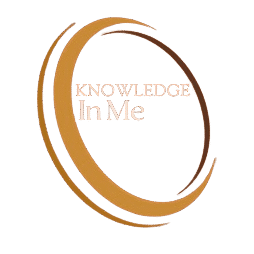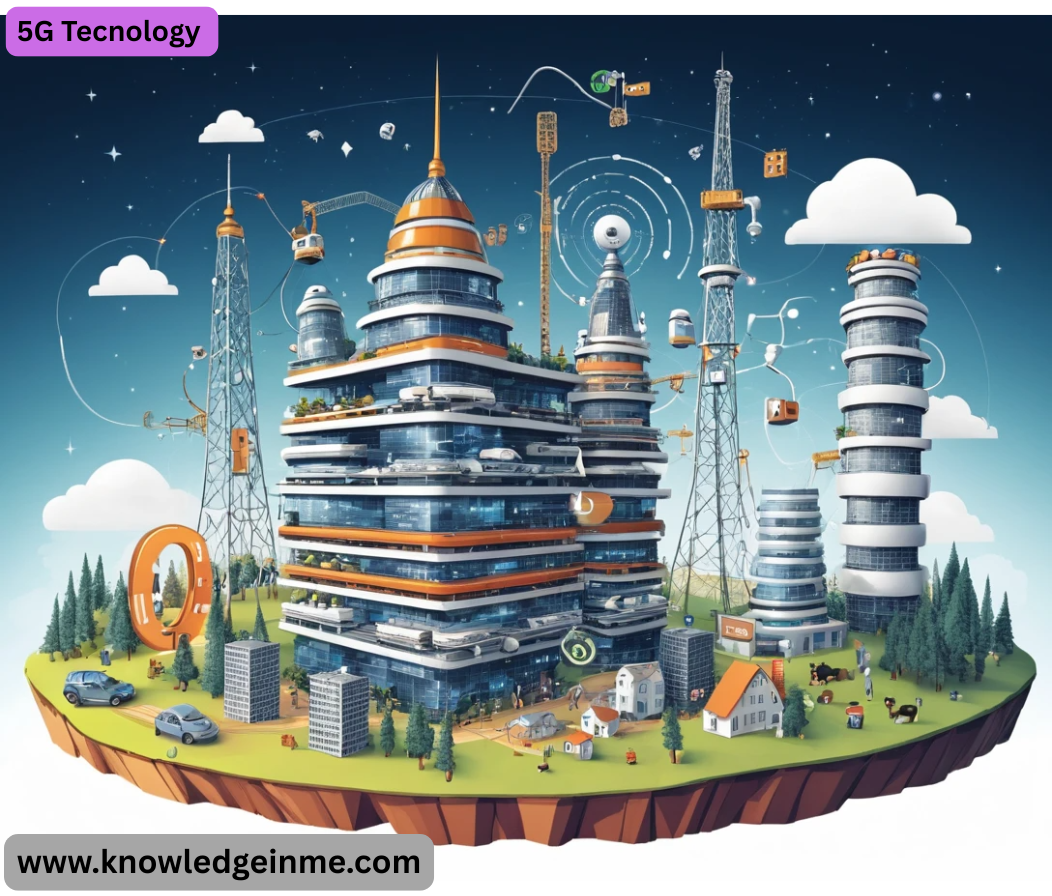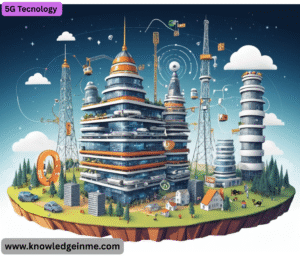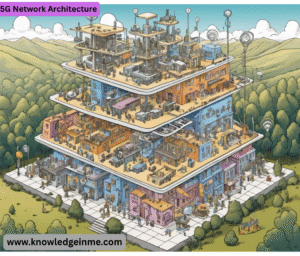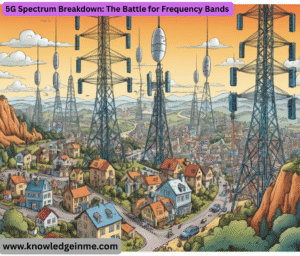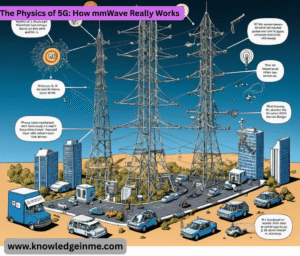5G Tecnology 5G technology is the fifth generation of mobile networks, offering significantly faster speeds, lower latency, and greater connectivity than previous generations (4G/LTE). It is designed to support the growing demand for data, enable the Internet of Things (IoT), and revolutionize industries like healthcare, autonomous vehicles, and smart cities.
Key Features of 5G:
- Ultra-Low Latency (1ms or less) – Critical for real-time applications like remote surgery, gaming, and autonomous driving.
- Massive Device Connectivity (1M devices per km²) – Supports IoT ecosystems, smart homes, and industrial automation.
- Improved Reliability – Better for mission-critical communications (e.g., emergency services, industrial robots).
- Network Slicing – Allows customized virtual networks for different needs (e.g., gaming, enterprise, IoT).
How 5G Works:
- Uses higher-frequency radio waves (mmWave) for faster speeds but shorter range.
- Relies on small cells (compact base stations) instead of large towers for better coverage.
- Implements beamforming to direct signals efficiently to devices.
- Combines sub-6 GHz and mmWave bands for a balance of speed and coverage.
Applications of 5G:
- Enhanced Mobile Broadband (eMBB) – Faster smartphones, AR/VR experiences.
- IoT & Smart Cities – Connected sensors, traffic management, energy grids.
- Telemedicine – Remote surgeries and real-time health monitoring.
- Industry 4.0 – Smart factories with AI-driven automation.
Challenges of 5G:
- Infrastructure Costs – Requires dense small-cell deployment.
- Limited Range (mmWave) – Struggles with obstacles like walls and trees.
- Security Concerns – More entry points for cyber threats.
- Health & Environmental Debates – Some concerns over radiation (though studies show it’s safe within limits).
5G Network Architecture
- 5G uses a three-layer architecture for optimal performance:
- Radio Access Network (RAN) – Includes small cells, macro cells, and beamforming antennas.
- Core Network – Fully virtualized (cloud-native) with network slicing for customized services.
- Backhaul & Fronthaul – Uses fiber optics and microwave links for high-speed data transport.
Key Technologies Behind 5G:
- Sub-6 GHz – Balances speed and coverage (used in most deployments).
- Massive MIMO (Multiple Input Multiple Output) – Uses dozens of antennas for better efficiency.
- Edge Computing – Processes data closer to users (reducing latency).
- Africa & Latin America are lagging due to infrastructure costs.
- China leads in 5G patents (Huawei, ZTE), while the US focuses on Open RAN (to avoid Huawei dependency).
Health & Environmental Concerns
Radiation Myths vs. Facts:
- Myth: 5G causes cancer or COVID-19.
- Fact: 5G uses non-ionizing radiation (like Wi-Fi), which doesn’t damage DNA. WHO and FCC confirm safety within limits.
Real Concerns:
- 5G Tecnology Electromagnetic Interference (with weather satellites near 24GHz).
- Battery Drain (5G phones consume more power).
- E-Waste (faster device upgrades increase electronic waste).
Security & Privacy Risks
- Increased Attack Surface (more IoT devices = more vulnerabilities).
- Network Slicing Risks – Hackers could exploit virtual networks.
- Supply Chain Threats – Huawei bans in some countries due to espionage fears.
- Solutions: AI-driven security, quantum encryption (future).
Beyond 5G: What’s Next?
- 6G (2030+) – Expected to deliver 1 Tbps speeds, AI-native networks, and terahertz (THz) frequencies.
- Satellite 5G (e.g., SpaceX Starlink + T-Mobile partnership for global coverage).
- Wi-Fi 6E & 5G Convergence – Seamless switching between networks.
5G Spectrum Breakdown: The Battle for Frequency Bands
Global Disputes:
- The C-band (3.7–4.2 GHz) caused FAA vs. telecom clashes in the US (interference with altimeters).
- China dominates Sub-6 GHz, while the US pushes mmWave (but pivots to mid-band due to coverage issues).
Advanced 5G Use Cases (Beyond Smartphones)
A. Private 5G Networks
- Factories, ports, mines deploy dedicated 5G for ultra-reliable low-latency communication (URLLC).
- Example: BMW’s 5G smart factory uses AR-guided assembly lines.
B. Digital Twins + 5G
- Real-time virtual replicas of cities, power grids, or human organs for simulation and monitoring.
C. Holographic Communication
- 5G Tecnology 3D holograms transmitted in real time (e.g., for remote meetings or concerts).
- South Korea’s KT showcased a live hologram of K-pop stars in 2023.
D. Tactile Internet
- Haptic feedback over 5G enables remote surgery robots to “feel” tissue resistance.
- Combined with AI diagnostics, this could enable global telemedicine.
The Geopolitics of 5G: US vs. China Tech War
- Huawei Ban & Open RAN Movement
- Open RAN (O-RAN) promotes vendor-neutral networks (backed by US/EU to counter Huawei).
6G Patent Race
- China holds 40% of 6G patents (vs. 35% for the US) as of 2024 (Nikkei report).
- Key players: Huawei, Samsung, Qualcomm, Nokia.
5G Security: The Quantum Threat
Vulnerabilities:
- Fake base stations (“Stingrays”) can intercept 5G signals.
- AI-powered DDoS attacks exploit network slicing.
Solutions:
- Post-Quantum Cryptography (PQC): NIST is standardizing algorithms resistant to quantum hacking.
- Zero Trust Architecture (ZTA): Requires continuous authentication.
Energy Efficiency: Is 5G a Climate Problem?
The Paradox:
- 5G Tecnology But total energy use may triple by 2025 due to denser networks (GSMA).
Green 5G Strategies:
- AI-driven sleep modes for idle base stations.
- Renewable-powered small cells (e.g., solar/wind).
The Road to 6G (2030+)
Expected Features:
- Terahertz (THz) bands (100 GHz–10 THz) for 1 Tbps speeds.
- AI-Native Networks: Self-optimizing, predictive maintenance.
- Brain-Computer Interfaces (BCI): Ultra-low-latency neural links.
- 3D “Network in the Sky”: Integrated satellite, drone, and terrestrial networks.
Timeline:
- 2025–2027: 6G standardization begins (ITU-R “Network 2030” framework).
- 2028–2030: First 6G trials (likely in China, US, or Japan).
The Dark Side of 5G: Ethical & Societal Risks
- Surveillance States: China’s 5G + facial recognition enables mass monitoring.
- Job Displacement: AI + 5G automation could disrupt logistics, manufacturing.
- Digital Divide: Rural areas may lag in 5G access, worsening inequality.
The Physics of 5G: How mm Wave Really Works
A. Milli meter Wave (mm Wave) Propagation Challenge
- Atmospheric Absorption:
- Oxygen absorbs 60 GHz (“oxygen resonance band”), limiting range.
- Rain attenuates signals above 10 GHz (bad for outdoor mm Wave).
Free-Space Path Loss:
- Signal strength drops with distance² (unlike lower frequencies).
- Example: A 28 GHz signal loses 20 dB more power than 3.5 GHz at the same distance.
B. Beamforming & Phased Array Antennas
- Analog vs. Digital Beamforming:
- Analog: Uses phase shifters (cheaper but less precise).
- Digital: Processes signals individually (used in Massive MIMO).
Real-World Impact:
- Enables dynamic tracking of moving devices (e.g., a self-driving car).
C. Overcoming Obstacles: Repeaters & Reflective Surfaces
- Intelligent Surfaces (RIS):
- Walls coated with metamaterials that reflect 5G signals directionally.
- Trials in Tokyo showed 30% signal boost in dead zones.
The “5G Divide”: Developing Nations Struggle
- 5G Tecnology Africa’s 5G Lag: Only South Africa, Nigeria, Kenya have limited deployments.
- Reason: High infrastructure costs ($200K per small cell vs. $20K for 4G macrocell).
India’s Jio 5G Play:
- $25B investment to cover 90% of population by 2025.
- Uses standalone (SA) 5G core (unlike US non-standalone).
5G & The Metaverse: Building the Internet of Experiences
A. How 5G Enables the Metaverse
- Latency Requirements:
- <10ms for smooth VR (5G delivers 1ms with edge computing).
Bandwidth Needs:
- 8K 360° VR streams require 100 Mbps per user (5G handles this).
B. Real-World Metaverse + 5G Projects
- NVIDIA Omniverse + 5G:
- Meta (Facebook) & Verizon Partnership:
- Testing cloud-based VR gaming over mmWave.
